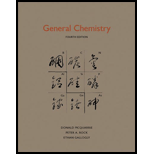
Concept explainers
(a)
Interpretation:
The given species
Concept Introduction:
Bronsted-Lowry Acids: If a species loses a proton then it is considered as Bronsted-Lowry acids
Bronsted-Lowry Bases: If a species receives one proton, then it is considered as Bronsted-Lowry bases
If a base receives one proton, then the formed species is called as conjugate acid whereas an acid lose one proton, then the formed species is denoted as conjugate base.
(b)
Interpretation:
The given species
Concept Introduction:
Refer to (a).
(c)
Interpretation:
The given species
Concept Introduction:
Refer to (a).
(d)
Interpretation:
The given species
Concept Introduction:
Refer to (a).
(e)
Interpretation:
The given species
Concept Introduction:
Refer to (a).
(f)
Interpretation:
The given species
Concept Introduction:
Refer to (a).
Want to see the full answer?
Check out a sample textbook solution
Chapter 20 Solutions
General Chemistry
 ChemistryChemistryISBN:9781305957404Author:Steven S. Zumdahl, Susan A. Zumdahl, Donald J. DeCostePublisher:Cengage Learning
ChemistryChemistryISBN:9781305957404Author:Steven S. Zumdahl, Susan A. Zumdahl, Donald J. DeCostePublisher:Cengage Learning ChemistryChemistryISBN:9781259911156Author:Raymond Chang Dr., Jason Overby ProfessorPublisher:McGraw-Hill Education
ChemistryChemistryISBN:9781259911156Author:Raymond Chang Dr., Jason Overby ProfessorPublisher:McGraw-Hill Education Principles of Instrumental AnalysisChemistryISBN:9781305577213Author:Douglas A. Skoog, F. James Holler, Stanley R. CrouchPublisher:Cengage Learning
Principles of Instrumental AnalysisChemistryISBN:9781305577213Author:Douglas A. Skoog, F. James Holler, Stanley R. CrouchPublisher:Cengage Learning Organic ChemistryChemistryISBN:9780078021558Author:Janice Gorzynski Smith Dr.Publisher:McGraw-Hill Education
Organic ChemistryChemistryISBN:9780078021558Author:Janice Gorzynski Smith Dr.Publisher:McGraw-Hill Education Chemistry: Principles and ReactionsChemistryISBN:9781305079373Author:William L. Masterton, Cecile N. HurleyPublisher:Cengage Learning
Chemistry: Principles and ReactionsChemistryISBN:9781305079373Author:William L. Masterton, Cecile N. HurleyPublisher:Cengage Learning Elementary Principles of Chemical Processes, Bind...ChemistryISBN:9781118431221Author:Richard M. Felder, Ronald W. Rousseau, Lisa G. BullardPublisher:WILEY
Elementary Principles of Chemical Processes, Bind...ChemistryISBN:9781118431221Author:Richard M. Felder, Ronald W. Rousseau, Lisa G. BullardPublisher:WILEY





